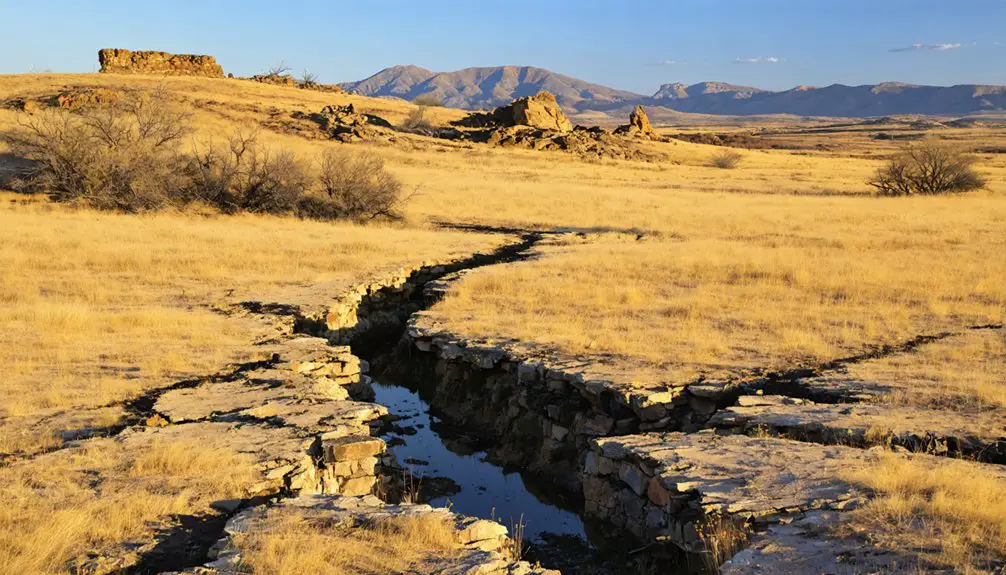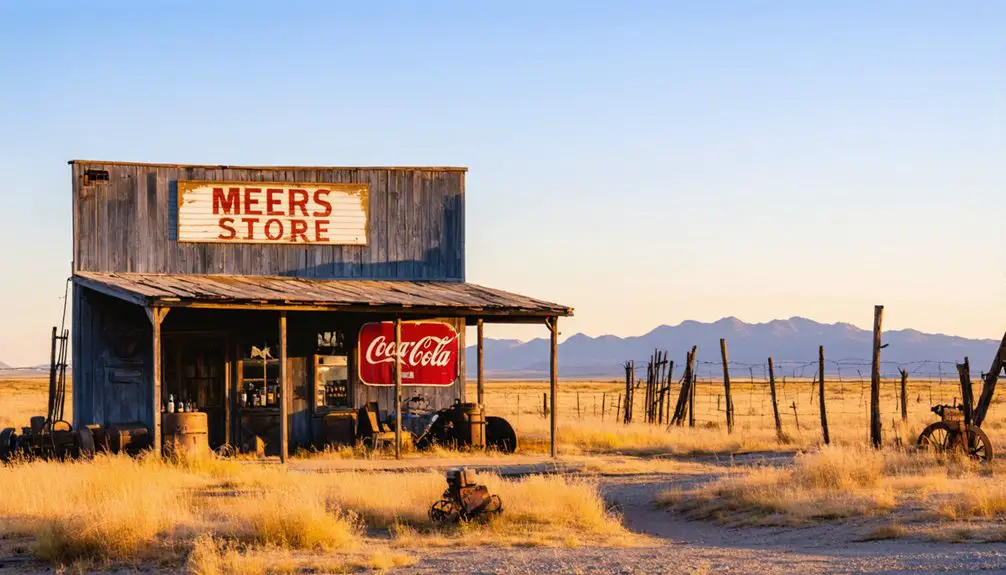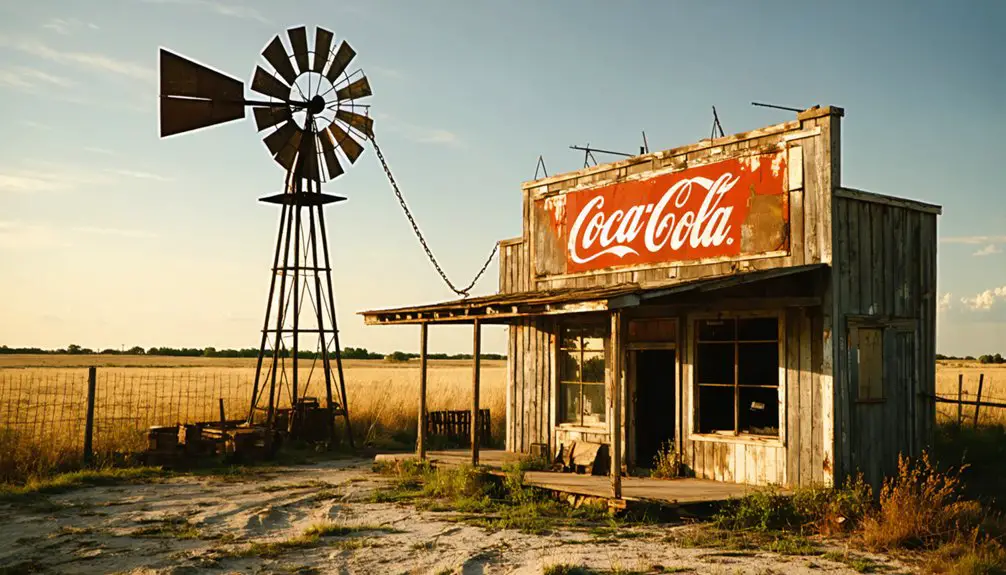You’ll discover Meers, Oklahoma as a former gold rush town established in 1901 in the Wichita Mountains. At its peak, the settlement drew 500 residents and 20,000 miners who filed over 2,000 mining claims. While the gold dreams faded quickly, the historic Meers Store remains as the last original structure, now famous for its Longhorn burgers. The town’s rich history intertwines with the scientifically significant Meers Fault, offering layers of fascinating stories to uncover.
Key Takeaways
- Meers began as a gold prospecting settlement in 1901, reaching a peak population of 500 residents during the Oklahoma gold rush.
- The town declined rapidly when gold deposits proved less profitable than expected, causing miners to leave for better opportunities.
- Only the historic Meers Store remains from the original town, now serving as a famous restaurant listed on the National Register.
- The closure of the post office in 1989 marked the official end of Meers as an active settlement.
- The ghost town sits near the significant Meers Fault, which extends 25-37 kilometers through southwestern Oklahoma.
The Gold Rush Origins and Early Development
While Spanish explorers had searched southwestern Oklahoma for precious metals centuries earlier, leaving behind evidence like a 16th-century arrastra near Meers, the town’s true origins began in 1901 when it emerged as a gold prospecting settlement in the Wichita Mountains.
Named after Andrew J. Meers, a mine operator from Georgia, the town quickly became the region’s most extensive mining district.
You’ll find that during the peak of the gold rush, nearly 20,000 miners flocked to the area, filing over 2,000 mining claims.
The town’s population swelled to 500 residents as mining infrastructure expanded, including smelters and equipment. To avoid confusion with similar place names, locals often referred to the settlement as Meers Mining Camp.
Prospectors dug shafts up to 200 feet deep, processing ore that varied dramatically in value from less than $1 to over $600 per ton.
By the end of the twentieth century, the once-bustling mining town had dwindled to just four residents remaining.
From Boom to Ghost: A Mining Town’s Decline
The initial promise of Meers’ gold deposits proved fleeting, as the town’s mining yields diminished rapidly after the first wave of excitement.
Mining challenges mounted as operations struggled with limited infrastructure and difficult terrain in the Wichita Mountains foothills. The Waco Mining Company operated a prominent camp office there in 1904. The town’s economic vulnerability became apparent as miners departed for better opportunities, leading to widespread business closures and population loss. The town’s rich social history artifacts from 1900-1924 are now preserved through its listing on the National Register of Historic Places.
- Limited gold deposits and inconsistent mining operations failed to sustain long-term growth
- Geographic isolation and lack of railroad access hindered competitiveness
- Rival towns with better infrastructure drew away residents and commerce
- Environmental constraints complicated both mining and living conditions
- The post office’s closure in 1989 marked the final chapter of official settlement
Today, only the historic Meers Store remains as a monument to this once-bustling mining community.
The Historic Meers Store: A Living Legacy
While Meers’ mining glory days are long past, you’ll find its legacy alive at the Historic Meers Store, the only surviving original structure from the town’s prosperous era and now listed on the National Register of Historic Places.
Today, visitors can enjoy cozy nostalgic dining while surrounded by an array of tribal items available for purchase.
You can experience history firsthand in this century-old building, where the walls tell stories through vintage photographs, newspaper clippings, and artifacts dating back to 1901.
Beyond its historical significance, the store’s famous Longhorn beef burgers have earned national recognition from Food Network and Bon Appetit, drawing visitors from across the country to this preserved piece of Oklahoma’s past.
Traditional dining features meals served on aluminum pie plates with refreshing water in mason jars.
Historic Preservation Success Story
Standing as a tribute to successful historic preservation, the Meers Store represents the sole surviving structure from Oklahoma’s early 1900s gold rush era in Comanche County.
The building’s historic significance extends beyond its 1978 National Register listing, as it continues to serve the community through active engagement and scientific contributions. The establishment’s legacy as a post office and drugstore reflects its vital role in supporting the town’s early infrastructure.
- You’ll find the original frontier architecture maintained while operating as a thriving restaurant.
- The store’s preservation enables you to experience authentic gold rush heritage firsthand.
- Its dual role as the “MEO – Meers Observatory” advances geological research.
- You can explore one of America’s most sensitive seismic monitoring locations.
- The store’s preservation success drives tourism and sustains local economic growth.
The Meers Store exemplifies how protecting historical landmarks can simultaneously serve modern purposes while honoring the past.
Famous Longhorn Beef Burgers
Beyond its historic significance, Meers Store‘s enduring legacy lives on through its legendary Meersburger, a culinary masterpiece that’s drawn national attention for over five decades.
You’ll find this massive 7-inch patty made from 97% lean, grass-fed Texas longhorn beef, raised by owner Joe Marant since 1989. The burger ingredients include fresh purple onions, tomatoes, lettuce, and dill pickles, served on a distinctive pie pan that adds to its rustic charm. The restaurant welcomes guests with a wait-line entry similar to an amusement park experience.
Your dining experience at this cash-only establishment combines authenticity with tradition. The restaurant’s popularity is evident by its full parking lot daily. While you enjoy your medium-well cooked burger in the 114-seat restaurant, you’ll appreciate knowing you’re tasting prize-winning longhorn beef prepared using time-honored techniques.
Even your four-legged friends are welcome, with shaded kennels available outside this celebrated eatery.
Original Structure Still Standing
Among all the structures from the original gold rush town of Meers, you’ll find only one building has withstood the test of time – the historic Meers Store.
Built in 1901, this tribute to early Meers architecture has served multiple roles in the community, from post office to modern-day restaurant, while maintaining its original structural integrity. Similar to how railroad routing influenced other Oklahoma ghost towns, Meers faced economic challenges that led to its near-total abandonment.
- Listed on the National Register of Historic Places since 1978
- Served as the town’s post office for nearly 90 years
- Houses the sensitive Meers Observatory seismograph
- Reflects authentic early 20th-century mining town design
- Continues as a hub for community gatherings and commerce
The store’s preservation offers you a rare glimpse into Oklahoma’s frontier commerce, standing as the sole survivor of a once-bustling gold rush town and maintaining its role as an essential community landmark.
Geological Significance: The Meers Fault

Located in southwestern Oklahoma, the Meers Fault stands as one of the most significant geological features in the central United States, extending 25-37 kilometers as a prominent surface scarp.
The Meers Fault stretches across southwestern Oklahoma’s landscape, a striking testament to Earth’s dynamic forces beneath our feet.
You’ll find this remarkable fault’s characteristics include a northwest trend and reverse movement with left-lateral motion, cutting through both ancient Permian formations and younger Quaternary deposits.
The fault’s tectonic history reveals its origins as part of a failed Cambrian rift system that’s been reactivated multiple times over hundreds of millions of years.
You can observe its impressive vertical displacement of more than 9 kilometers, which has shaped the boundary between the Wichita Mountains and Anadarko Basin.
As one of the few active faults in the central U.S., it offers unique insights into intraplate tectonics and continues to influence the region’s landscape.
Scientific Research and Seismic Monitoring
You’ll find the Meers Fault Monitoring Station at the forefront of scientific research into one of Oklahoma’s most significant geological features.
Extensive seismic monitoring programs, initiated in 1984, combine geological mapping by the Oklahoma Geological Survey with aerial photography studies from the University of Nevada-Reno.
The station’s continuous data collection since 1978 has proven invaluable for understanding fault behavior, though it hasn’t recorded any recent earthquakes along the Meers Fault itself.
Meers Fault Monitoring Station
Since the Meers Fault poses a significant seismic risk in southwestern Oklahoma, the Oklahoma Geological Survey installed a dedicated monitoring station near the Meers Store in 1985.
You’ll find this station positioned at approximately 34°49′N 98°30′W, strategically placed to detect seismic activity and potential fault reactivation along the 54-kilometer fault line.
The monitoring station’s critical functions include:
- Continuous recording of microearthquakes and ground movements
- Collection of data for regional seismic hazard assessments
- Detection of subtle ground deformation patterns
- Integration with statewide earthquake monitoring networks
- Support for emergency response planning in Comanche County
While the fault currently shows no significant seismicity, the station’s data has helped confirm a major earthquake occurred here less than 2,000 years ago, highlighting the importance of ongoing surveillance.
Geological Research Significance
The Meers Fault represents a remarkable geological laboratory for understanding seismic activity in the central United States. You’ll find it’s the only known Holocene fault in Oklahoma with visible surface expression, making it vital for studying fault activity in the region.
Recent excavations have revealed at least three major paleoearthquakes, with the most recent occurring less than 2,000 years ago.
What makes this site particularly significant is its extensive earthquake record. Scientists studying the fault have discovered a 2.5-meter vertical bedrock separation and distinctive colluvial deposits that tell the story of past seismic events.
The fault’s 58-kilometer rupture length suggests it could potentially generate magnitude 7.1 earthquakes, making it an essential component in seismic hazard assessment for the central U.S.
Cultural Impact and Historical Preservation

Despite its small footprint in Oklahoma history, Meers has left an outsized cultural legacy through its iconic Meers Store & Restaurant, which stands as the sole surviving structure from the town’s gold rush era.
You’ll find this National Register-listed landmark continues to draw cultural tourism through its famous MeersBurger, while preserving essential local heritage from Oklahoma’s mining past.
- The Store served as the community’s post office for 87 years, anchoring local life until 1989
- You can experience authentic frontier culture through preserved mining camp architecture
- The site represents Oklahoma’s broader boom-and-bust mining town narrative
- It’s become a significant destination for heritage visitors studying early 20th-century prospecting
- Local historical societies work to maintain the site’s accessibility and educational value
Exploring Oklahoma’s Mining Heritage Today
Beyond Meers’ individual story lies Oklahoma’s rich mining legacy, which you can explore through numerous historic sites and educational centers across the state.
You’ll discover how mining techniques like room-and-pillar extraction helped Oklahoma lead U.S. zinc production from 1918 to 1945, with the Tri-State Mining District yielding 1.3 million tons of lead and 5.2 million tons of zinc.
The economic impact of mining shaped entire communities, from the coal fields of McAlester to the copper mines near Altus.
While large-scale metal mining ceased by the late 20th century, you can still witness the industry’s evolution through today’s active operations. Nearly 365 companies now hold permits to mine non-petroleum minerals at about 600 sites, employing 2,100 people in modern, safety-conscious operations.
Frequently Asked Questions
What Is the Current Population of Meers, Oklahoma?
You’ll find that current demographics show fewer than 50 residents in this historically significant mining town, though exact figures aren’t officially tracked since it’s now primarily a tourist destination with one restaurant.
Are There Any Remaining Original Structures Besides the Meers Store?
You won’t find any other original structures standing besides the Meers Store, which holds unique historical significance as the sole surviving building from 1901. Only scattered foundations and ruins remain.
How Large Was the Gold Mining Operation at Its Peak?
You’ll find the gold mining operation peaked between 1901-1910, with over 2,000 mining claims, dozens of smelters, and shafts up to 200 feet deep, though its historical significance remained regionally limited.
Can Visitors Explore the Abandoned Mine Sites Around Meers Today?
You can’t legally explore abandoned mine sites due to safety hazards and private property restrictions. While ghost town exploration is possible in public areas, mine sites remain off-limits without specific permissions.
What Native American Tribes Originally Inhabited the Meers Area?
Prehistoric peoples preceded powerful Plains tribes in your area. You’ll find the Wichita, Tonkawa, and Caddo Tribe were early inhabitants, while Comanche heritage later shaped the region around present-day Meers.
References
- https://en.wikipedia.org/wiki/Meers
- https://okmag.com/blog/gone-but-not-forgotten/
- https://www.okhistory.org/publications/enc/entry?entry=GH002
- http://blogoklahoma.us/place/492/comanche/meers-store-and-restaurant
- https://www.ghosttowns.com/states/ok/meers.html
- https://www.okhistory.org/publications/enc/entry?entry=WI002
- https://www.okhistory.org/publications/enc/entry?entry=GO003
- https://kids.kiddle.co/Meers
- https://www.hmdb.org/m.asp?m=174849
- https://gateway.okhistory.org/ark:/67531/metadc1594968/



